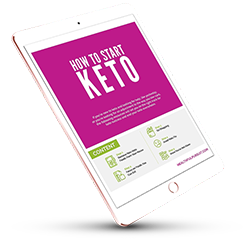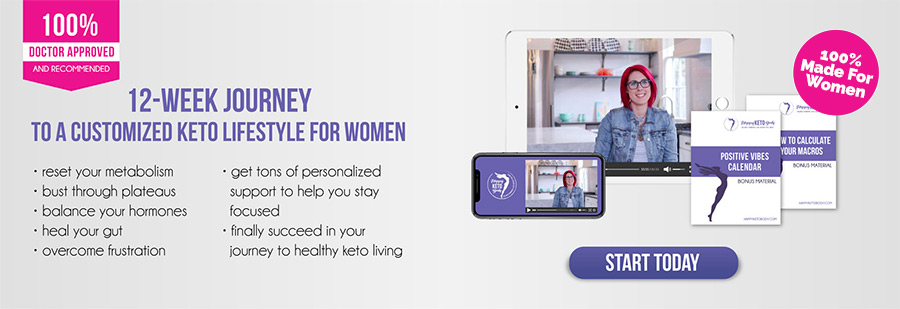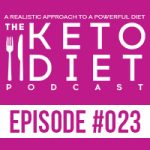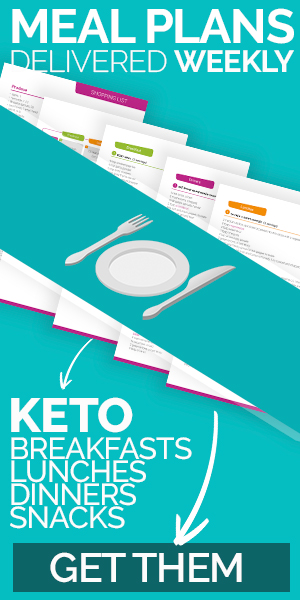I want...
The Ultimate Guide to Understanding Animal Protein
December 9, 2020 By
Leanne Vogel

 October 20, 2021
October 20, 2021
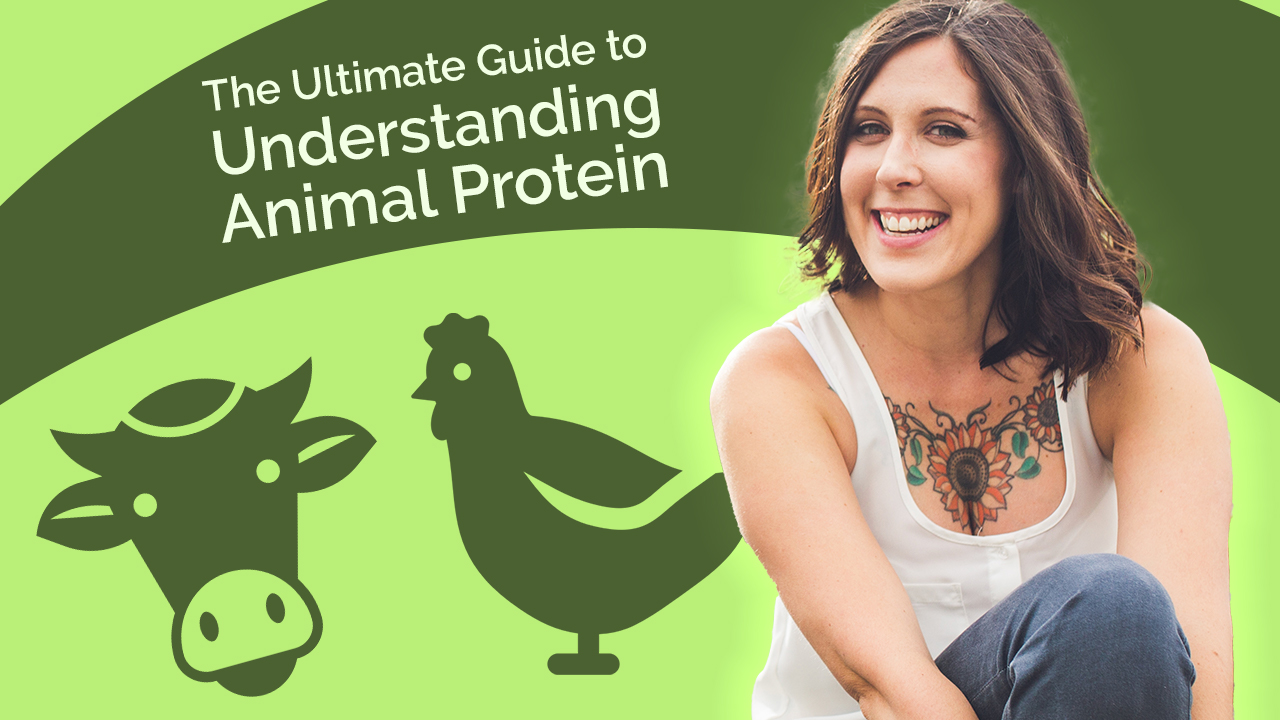
There are so many ways to care for your health. One of the big ones, especially if you eat animal protein, is focusing on the quality of the meat you eat. There are a lot of options available nowadays – every company is trying to cash in on the grass-fed market. What do you look for? What are the best options? Why should you care? Today’s podcast guest, Anya Fernald is here to shed some light on it all.
Grass-fed/Finished v. Grain-fed | Regenerative Agriculture | The Life of a Cow | The Life of a Chicken | Direct v. Grocery Store | Finding a Good Farm | The “Organic” Label | “Air Chilled” Chicken | Beef Labeling | Protein a Priority
Keto shopping lists, recipes, and more! Start keto with this FREE 5-step guide.
I'm ready!I used to be vegan. And now, I eat ethically raised animal protein at nearly every meal because well, after reading today’s post… you’ll want to, too.
Many people on the keto diet find that they eat a lot of meat. It’s the perfect food for balanced macros and, if it’s a clean source of meat, it contributes to balanced micronutrients as well! There are many reasons why I choose humanely-raised meat from ethically-conscious companies. Not only am I assured that the animals were treated well, but the nutrients in each serving are much, much higher than conventionally raised sources.
Quality matters. And, in today’s post, we’re going to highlight some of the differences between conventionally raised meat on not just your health, but also the planet, and why you should care about the matter at which the animal is kept before slaughter.
If you’re not much for reading, we have you covered! Here’s a recording of The Keto Diet Podcast where we cover all of the items in today’s blog post, via audio – no reading!

Nutrition Differences
Here is the difference between grass-fed and grain-fed beef. And, it tastes better, too!
Grass-fed/Finished Beef
- 3X higher in omega-3 fats (anti-inflammatory)
- Antibiotic-free
- higher stearic acid (SFA), that conventional medical community agrees doesn’t raise blood cholesterol levels
- 2 to 3X more CLA (antioxidant)
- Higher vitamin E
- Higher glutathione
- Higher minerals such as zinc, iron, phosphorus, sodium, and potassium
Grain-fed Beef
- 6X higher in omega-6 fats (inflammatory)
- 2 to 3X less CLA (antioxidant)
- Lower vitamin E
- Lower glutathione
- Lower minerals such as zinc, iron, phosphorus, sodium, and potassium
Whether grass-fed or grain-fed, the fat content (between saturated, monounsaturated and polyunsaturated) is the same. At 40-50% saturated fat, about 40-50% monounsaturated fat, and 10% polyunsaturated fat. However, the types of saturated, monounsaturated and polyunsaturated is VERY important.
As I’ve dug into the benefits of clean, quality protein, it can get a little frustrating to see just how inaccessible these products are for the masses. I count myself very lucky to be able to consume clean protein that’s humanely raised, organic, and grass-fed. And, if this isn’t an option for you, no worries. Bookmark today’s post and come back to it when it is, or take bits and pieces of information as it relates to what’s accessible for you.
Regenerative Agriculture
This is agriculture that enhances the fertility of the soil and the earth as opposed to being solely extractive. In regenerative agriculture, the livestock are used to enhance the fertility of the soil.
Regenerative is also labelled “traditional” in some cases. Basically, it is the traditional way of raising the animals in accordance to their natural evolutionary diet in a free-range system.
99% of American agriculture is not regenerative or traditional in nature but conventional in nature. Minimal tracing, and a lack of appreciation and respect for the diet or needs of the animals and the land they live on.
“Regenerative” is not something that’s certified, though it does need to be verified as a claim. So, if it’s on packaging, the farm has to explain to the government why they’re using that word and document it properly to get approved. So, though it’s not a certification, it is a claim that is verified.
Fun fact… the average McDonald’s hamburger has beef from 100 cows in it, verified by DNA testing. A hundred different cows in that hamburger. Wow. You can’t even believe how that’s possible. This is an extreme example of conventional agriculture and its effect on the quality and traceability of the meat we’re eating. The result? A darn cheap burger!
We see the risks of weak traceability. There’s an outbreak of salmonella and it’s traced back to three separate solar houses. And those three solar houses connect to eight feedlots. That’s a lot of property to be shut down for a week or two because the traceability to an origin point is not easily rectified. And this is really the great trade off – not knowing where your beef comes from. I mean, no one really knows-knows where it came from! But, it’s cheap meat. So, there’s a tradeoff.
Also, with regenerative/traditional agriculture, we have to look at the environment as a whole. We hear companies like impossible meats and beyond meats share the water usage, the scary diagrams of methane gas production… all created by conventional agriculture. And, all that stuff they share is broadly correct.
Confinement beef in particular and chicken and pork close behind it, are some of the worst actors in terms of environmental degradation. You have thousands upon thousands of animals being raised, and creating waste products which aren’t properly managed. It’s like allowing your kid to pee in the backyard once in a while. Not a big deal, right? Well, imagine 1,000 kids peeing in a kiddy pool every day for a week. Kinda a big deal. This is what conventional agriculture is doing.
The second issue with conventionally raised animals versus regenerative practices, is that the animals are being fed subsidized human food crops. Meaning, the feed is so cheaply made with heavy usage of nitrogen-based fertilizers, that the feed is also contributing to the degradation of the environment.
And the third issue and differentiator between conventional agriculture and regenerative is with the nature of confinement, which we get into a bit later in this article also. Which confinement come antibiotics. Even though companies like Tyson will say that they do not use prophylactic antibiotics (which means that they don’t just give the animals antibiotics without them being sick), there are ways around this.
It’s been documented by various veterinarians from that system that have turned, that these large corporations basically keep vets on payroll to continually diagnose the animals as being at risk of being sick so that they can continually prescribe antibiotics without having to report because they’re not “prophylactic antibiotics”.
Why antibiotics? Antibiotics increase weight gain, as much as doubling the weight of the animal when nothing else is changed in their diet or lifestyle practices. The antibiotics suppress their microbiome which makes the digestive system less efficient at metabolizing and this sparks an inflammatory response in the animal.
These three factors are what really make confinement agriculture so bad for the environment. And, this is the sad story of livestock farming: it is indeed terrible for the environment.
The good story is that it doesn’t have to be. There’s another way of farming where the environment can be respected, enhanced, and encouraged. And that’s the traditional way of doing things. Animals and livestock are a key part of human history. Getting back to our roots and curating the earth, properly is doable! Livestock farmers used to be thinking about these things. The question, “How is the farm going to provide five generations from now?”, is not something that is asked as much anymore. And, this is one of the goals of traditional farming – to truly care for the earth and all it provides.
The Life of a Cow
Conventional
Access:
15 square feet per cow in a feedlot environment
Lifespan:
16 or 17 months
Regenerative
Access:
3 acres per cow
Lifespan:
25 to 26 months
Cows are ruminants meaning they eat grass.
But imagine for ourselves, if you were to imagine, say you wanted to gain 10 pounds and you were to do it by walking around a garden, eating seasonal greens, compared to eating a big bag of Fritos. What’s going to make us fat? It’ll be really hard to gain weight quickly eating all the greens.
That’s the equivalent of the operation in conventional versus grass-fed and regenerative systems. So, the beef fattening operation, which is feedlot-based, is called a maladaptive. This means the cattle are on a diet that doesn’t work for them.
Cows have five big stomachs that are designed to take really low value food of grasses and high fiber nutrient poor foods and convert them into sustenance for their bodies. So, they have these five stomachs that take this really rough high fiber food and convert it into calories, which they need five stomachs to do.
On the flipside, low nutrient monogastric beings like humans, pigs or chickens can’t handle this sort of process. We don’t have enough stomachs for it!
If cows eat nutrient dense food, like seeds for example, they get very sick. And, when they are fed these foods that are maladaptive for their composition, they get inflamed. They gain weight very, very quickly. And, this is at the core of the reason why American meat is so expensive. Not only that, but it has so low value that we only use about 40% of the animal, and the rest is thrown away.
What to look for in beef: grass fed and finished + free range.
Grass-fed beef should not have a livery taste to it! Or, have dark spots in the ground. These are signs that the animals were harvested too young and/or experienced stress during harvest. Likely both. And, in order to understand why this happens, we have to understand where the cattle is coming from.
Grass fed and finished operators tend to be small operations with small budgets, small holdings, and a likely cash flow issue. When they find a buyer, they may have to harvest animals at, say, 19 months – too soon in the animal’s lifespan, which results in the livery taste. When they get a buyer, they have to act on it or otherwise risk their cattle getting too old and missing the mark.
Since these smaller farms likely don’t have their own slaughterhouses, they coordinate transport of their cattle to large industrial plants where the stress of the animal is increased through transport and processing which ultimately leads to poor quality taste and texture.
Why would an industrial plant lead to poorer quality protein at the end of the cow’s life? When cows are processed in a huge industrial plant, they are 1 of 600 cows processed every hour (versus smaller plants at 50 cows a day). Everything is mechanized which leads to higher stress on the animal. Again – 600 cows an hour.
Unfortunately, many grass-fed/finished operators are constrained by economics to harvest a little too young and give the cows a high dose of stress during their final days.
One crazy stat is that pork in America is typically trucked five days to slaughter. 5 days.
The Life of a Chicken
The Life of a Chicken
Conventional
Feed:
100% corn
Lifespan:
2.5 weeks
Regenerative
Feed:
Grass, forage diet, grains
Lifespan:
10 weeks
The corn a chicken is fed is high in sugar and super different on the body when compared to their natural foraging diet. So, can corn really bubble up these chickens in 2.5 weeks verses the 10 weeks taken in a traditional setting? This is where prophylactic antibiotics come in.
Prophylactic antibiotics increase weight gain by creating an inflammatory response in response to the stressful environment they are raised in.
The chickens are kept in confinement hoop houses where there’s literally thousands of thousands of birds. To avoid death and further infection, their beaks are cut off because they’re under so much stress that if they have their full beaks, they would peck each other to death as a stress response. The chickens are kept in the dark, running around in their own feces, effectively eating a slurry of grains because they don’t have beaks to properly gather food.
Yeah, so you don’t need me to tell you that this is a horrific environment. And I’d say, if you would like to be an agent of change in animal agriculture, start with your chicken source. These conventionally-raised chickens produce a flaccid, puffy, inflamed, very, very poor-quality protein.
Ever had gritty chicken? A granular texture of the protein? This is a sign that the chicken was raised too fast.
Or, when cooking your chicken, a whitish looking liquid comes up? That’s actually the chlorine bath that these chickens are dumped in after slaughter.
What to look for in chicken: pastured, air-chilled.
Direct versus Grocery Store
It’s difficult to know what the quality of life was of the animal protein you’re purchasing at the grocery store. When grocery stores partner directly with the farmers, you can find some beautiful products. You’ll find these options at smaller one-stop grocery stores and less at chains like Save On, Safeway, Publix, or Whole Foods.
Grocery stores will typically double the price of the product on the shelves. So, if they buy from the farmer at $6 a pound it will be $12 a pound for the consumer. If sold to a chain, the farmer needs a distributor and a broker so by the time that same $6 a pound meat hits the shelves it will be 3X more at $18 a pound. And, this isn’t feasible. And, that $6 a pound for meat, doesn’t provide much to the farmer.
Needless to say, there are big problems with the grocery model when looking for good quality meats, where you’re paying for the quality and not for the markups, brokers, distributors… I’d rather pay $12 direct for quality for $12 meat than through a grocer and pay $12 for $6 meat. You know what I’m saying?
Outside of grocery, there are local farms and purchasing animal proteins directly from those farms, CSA programs in your area, or purchasing direct through a farm that may be further away, and having it delivered. The only way that smaller operators can actually make money long-term, and continue to make quality products, is through selling directly.
Finding a Good Farm
So, what do you do? You’re standing at the grocery store… and, you don’t know which brands are safe, which to choose, what farms to engage with… Here are some tips for finding a good farm:
- They have a website, with a phone number and are open to phone calls and questions from potential customers. Call them up! Ask questions, have a conversation…
- Go to their website. Does it look like a real farm? Is it “something farms LLC” with stock photos of animals? Often these “something farms LLC” are just packing houses, so they’re buying from feedlots, creating packaging, and calling themselves a farm.
- Look at their Wikipedia page. Find out if there’s a real farmer associated with it.
Understanding the “Organic” Label
Pork, chicken, beef, does organic matter?
Organic tells you nothing about the environmental sustainability or anything about humane treatment of animals. For example, most organic milk is produced in feedlots. The cows are being fed corn… but the quality of life is as we wrote about above.
Most organic chicken is produced in extremely confined environments not that dissimilar from a conventional chicken.
If you’re looking for an indicator of animal wellness, the organic is not it.
What the organic label will tell you is that the company/farm you’re purchasing from has better diligence, better record keeping and no use of petroleum-based chemicals in agriculture.
I’ve been told many times that the organic certification is quite costly, which is why a lot of companies choose not to do it. The cost of getting the certifier to come to your firm is not what costs… but rather, the record keeping is what buries some small farms. The record keeping associated with maintaining organic certification is a lot of operations for a small farm.
Organic can be a good indicator of the rigor on the part of the farmer in general and on the supply chain and especially in a system like the US where there’s very little mandates around traceability, record keeping, or in general practices. The organic certification confirms that things are all on the up and up.
Labeling a meat product “organic” doesn’t provide the whole picture. But, combining organic with the regenerative aspect as written above, we’re looking for practices that are actively increasing organic matter in the soil and soil health and fertility. That’s better and bigger than organic.
Organic is a great starting point, but you should be looking at more than just “organic”. If the package says “Organic” and something else, this is a good next step. And, I’ve described the “something else” below to give you some ideas of what to look for in addition to the organic labeling.
Understanding “Air Chilled” Chicken
Air chilled means no dunking in a chlorine bath after processing. Chlorine baths increase the weight of the chicken since they’re sold by weight.
Why chlorine? What’s the deal? So, the chicken goes through rigor mortis right after processing. Rigor mortis makes the tissue thirsty for water, similar to how your body will absorb water into a bruise. After any traumatic event, musculature will absorb water. So, the chicken puffs up and is prime to receive some liquids to increase weight! But this isn’t the only reason why chicken is dunked in a chlorine bath…
The other reason is that there’s a lot high risk of fecal contamination when processing chicken because of the layout of the bird and the size of it. So, dunking it in bleach reduces the risk factors of fecal contaminants remaining in your food. That said, even with the chlorine bath, much of American chicken products are contaminated with fecal matter despite the bleach bath.
When buying direct from a farmer who processes slowly and with care, you’re getting some nice benefits in terms of food safety.
Look for the Word “Pastured” on the Labeling for Chicken, Pork, and Lamb.
I want to see the word pastured, not just free range because free range legally means they have access to pasture, but that can be a small door in a hoop house. Whereas pastured means that they have to spend the majority of their life outside in pasture which is a big difference. This fact alone is what slows weight gain down and contributes to a nice athletic musculature.
How do you know your chicken was athletic? The color! You want to see a pinkish reddish bird. This is a great sign that they had a happy life working those muscles, out in the sunshine!
If you’re curious… pastured trumps organic. Pastured is more meaningful in terms of the actual health of the protein.
Though air chilled, pastured, organic chicken is perfection, the organic labelling isn’t a “must have”.
Understanding Beef Labeling
The 3 key words for beef are: free range, grass fed AND grass finished. This combo is very critical. Missing one? No good. Has organic added? Great!
Why grass finished? Why does it matter? Many farmers take beef off of grass for two weeks at the end of his life and are put on a little bit of barley at the end of the ration to pump things up a bit and completely changes the omega-3 to 6 ratios, rendering the meat less healthful. It’s sad, really. They take a beautifully raised cow whose ratios of essential fatty acids are on point, and then increase inflammation which in turn, affects the omega ratio for the end product.
Making Protein a Priority
Prioritizing our health and wellness is the most important thing an individual can do to take charge of their lives. 2020 has clearly shown us how rough it is for so many Americans who don’t have a handle on health and don’t know how to make change toward the betterment of their health. More and more people are understanding that wellness is the first step to having every day be close to awesome.
And, it requires that we choose it, and prioritize it before a lot of other things in our lives. If you have $300 to spend on your cellphone bill a month, but you can’t cut down on the data usage and prioritize your body? Naw, you can! You’re just choosing not to. And, this is really how simple it is!
Prioritize your health, understand your food choices, EMPOWER yourself. There are many ways to do this. And, I feel it starts with food.
Here’s to better meat that’s good for your body, for the animal, and for our environment!
Hi! I'm Leanne (RHN FBCS)
a Functional Medicine Practitioner, host of the Healthful Pursuit Podcast, and best-selling author of The Keto Diet & Keto for Women. I want to live in a world where every woman has access to knowledge to better her health.
